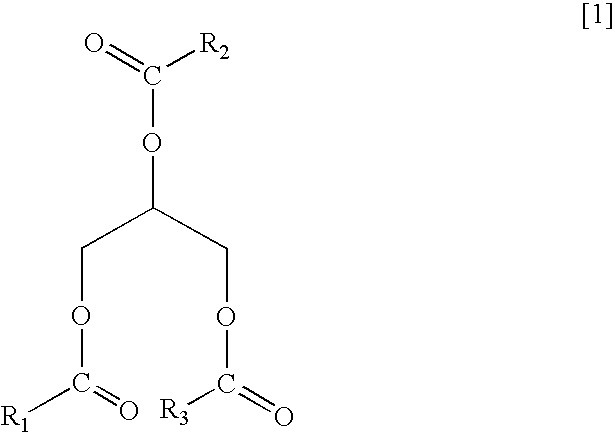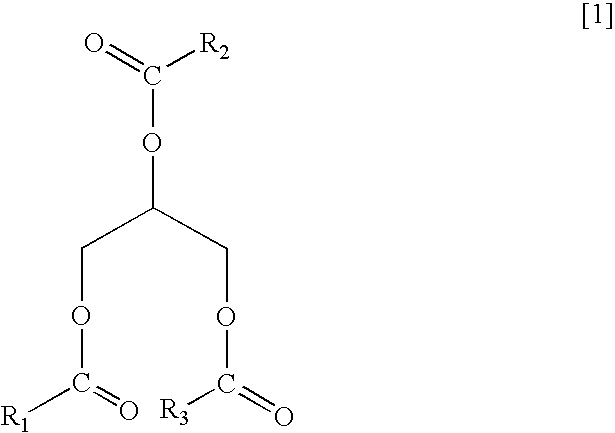Hydrophobic additive for use with fabric, fiber, and film
a technology of additives and hydrophobic materials, applied in the direction of liquid repellent fibres, weaving, synthetic resin layered products, etc., can solve the problems of skin irritation, labor-intensive, and difficult silicone component application to non-woven fabrics in the manufacturing process, and achieve the effect of increasing the hydrophobicity of non-woven fabrics
- Summary
- Abstract
- Description
- Claims
- Application Information
AI Technical Summary
Benefits of technology
Problems solved by technology
Method used
Image
Examples
example 1
[0071]Meltblending of the lipid ester into the carrier polymer is conducted under the following conditions. The extruder is a nine-zone Leistriz 34-mm twin screw extruder. The screw has a length to diameter (L / D) ratio of 38. The screw is a 34-mm diameter co-rotating screw with high-pitched kneading and turbine mixing elements.
[0072]Solid lipid ester is optionally blended with the carrier polymer in a low intensity mixer and introduced in zone 1. The extruder has an optional liquid injection port in zone 4, which is capped when adding a solid lipid ester and is open when adding a liquid lipid ester. The extruder is vented to the atmosphere at zone 6. The extruder's die has two holes and uses a 20 mesh screen immediately before the die.
[0073]The screw speed is set at 300 revolutions per minute (RPM). The temperature settings in each zone of the extruder are as follows:
Carrier polymerCarrier polymerZonePolyethylenePolypropylene1150° F.150° F.2320° F.380° F.3320° F.380° F.4330° F.380° ...
example 2
[0081]Spun-bonded and meltblown fabrics are prepared using polypropylene having either a 1 wt. % loading of glycerol tristearate as the active lipid ester ingredient or a fluorinated organic compound FX-1801 as the active ingredient. With no oven aging of the fabrics, the hydrohead is measured according to method IST 80.6 (0.01).
Sample-Active IngredientHydrohead25 gm / m2 polypropylene fabric control15.11 wt. % glycerol tristearate15.91 wt. % fluorinated organic compound15(FX-1801)11The fluorinated organic compound is supplied by 3M Corporation, (St. Paul, MN).
example 3
[0082]Spun-bonded and meltblown fabrics are prepared using polypropylene having either a 2.5 wt. % loading of glycerol tristearate as the active ingredient or a fluorinated organic compound Uniplex FE 700 plus 0.35 wt. % triglyceride) as the active ingredient. With no oven aging of the fabrics, the alcohol repellency is measured according to method IST 80.8. The alcohol repellancy rating number is one-tenth of the alcohol repellency measured according to IST 80.8.
Alcohol RepellencySample-Active IngredientRating Number25 gm / m2 polypropylene fabric2(control)2.5 wt. % glycerol tristearate32.5 wt. % fluorinated organic3.5compound (fluorinated organiccompound Uniplex FE 700 plus0.35 wt. % triglyceride)11The fluorinated organic compound is supplied by Unitex Chemical Corporation, (Greensboro, NC).
PUM
| Property | Measurement | Unit |
|---|---|---|
| contact angle | aaaaa | aaaaa |
| contact angle | aaaaa | aaaaa |
| wt. % | aaaaa | aaaaa |
Abstract
Description
Claims
Application Information
 Login to View More
Login to View More - R&D
- Intellectual Property
- Life Sciences
- Materials
- Tech Scout
- Unparalleled Data Quality
- Higher Quality Content
- 60% Fewer Hallucinations
Browse by: Latest US Patents, China's latest patents, Technical Efficacy Thesaurus, Application Domain, Technology Topic, Popular Technical Reports.
© 2025 PatSnap. All rights reserved.Legal|Privacy policy|Modern Slavery Act Transparency Statement|Sitemap|About US| Contact US: help@patsnap.com


